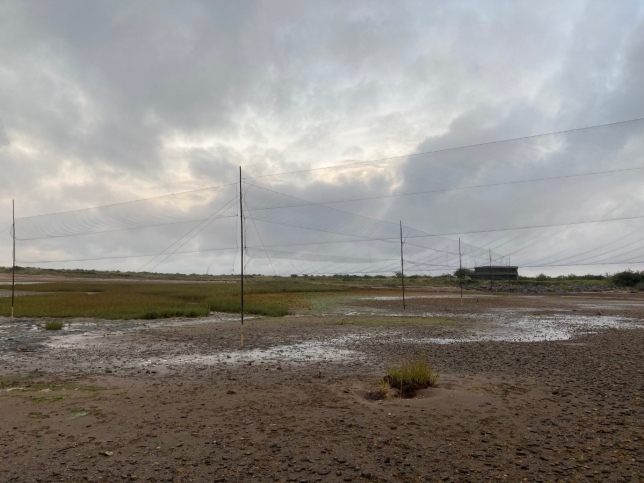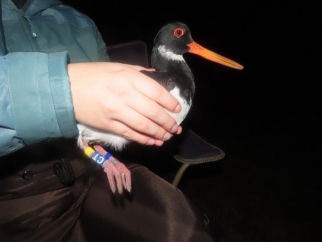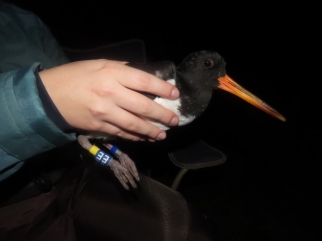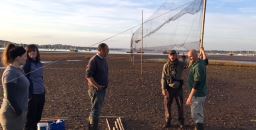High Tide 3.65m @ 21:56, Sunset 19:06
The main objective was to catch at up to 6 juvenile oystercatchers to enable the remaining 6 UHF GPS (which downloads data to a base station) tags to be deployed. Mist netting early in the autumn is the better as early in the season there are a good proportion of juveniles, but they tend to spend less time at the roost and more time feeding on fields as the season goes on. After being unable to muster a large enough team in August, we had a great response and assembled a team of 12 people for our first session of 2021. After collecting the group’s 18 foot long poles from the RSPB base from Exminster Marshes, Tim Frayling arrived on site to transfer kit from his car to Dave Scott’s truck. From 4.30pm the rest of the team started to assemble and despite problems with trying to find a petrol station with any fuel left, the Cornwall contingent arrived in good time and we walked down to the site via the Warren Golf club track. Fortunately, we had a large team that carried the poles down following Dave’s truck, which was carrying all the kit.
The plan was to set 2 lines of nets around the island roost in front of the hide, however as we had a large team and plenty of nets this was adapted following a suggestion by Robbie Phillips to add a ‘T’ at the end of each line. Despite the fact that on every session there are 1,000+ oystercatchers at the Dawlish Warren roost, we only ever catch a small fraction of these so anything we can do to improve the changes of a catch is taken. The set was a line of a 4 nets in the direction of the hide to Finger Point, with single nets at 90 degrees at the end of the line. A second line, also with a ‘T’ at 90 degrees to the line, in the direction of the railway was set, a total of twelve 12 metre nets.
 Line of nets with T near Island roost © T Frayling
Line of nets with T near Island roost © T Frayling
Weather conditions were favourable with a cloudy sky and 6mph winds coming from the south. With the nets up at 18.45, a few hours before high tide, we set up the base camp on the golf course just behind the hide. Once the fish and chip order was taken, two of the team departed to collect the food, and we waited for darkness. The presence of two fisherman with bright headtorches kept the oystercatchers off Finger Point, and for most of the time the birds were in the ‘recharge’ area in the compartments where we normally set the cannon nets. Watching with the night vision scope we could see two birds in the net, were extracted and taken back to be ringed and processed, just before high tide at 10pm. With new members of the team it was an opportunity for people to ring oystercatchers for the first time. Robbie Phillips led the ringing and processing, including checking the various biometrics, which includes various bill measurements including bill length, bill depth, and bill tip measurements. Once processed the birds were all colour ringed, including an uncoded blue ring above the metal ring to indicate that bird has been GPS tagged. The two adult birds were then tagged by Andy Hoodless with Tim Frayling, who is training to fit tags. The two adult birds were fitted with GSM- GPS tags (which do not rely on a base station as they use the mobile phone network). At 22.20 another two adult oystercatchers were caught, processed and kept in keeping cages in the dark so they could be tagged. The next net check produced another 4 birds were caught, including 3 juveniles, which was fantastic news as we wanted juveniles for tagging. Around 23.15 with the tide dropping some of the team went out to take the nets down and found more birds in the net. The total catch was 12 oystercatchers, 7 were juvenile and 5 were adult. This was fantastic as it allowed to deploy our remaining 6 UHF tags on juveniles, and 5 GSM-GPS tags on adults.
 Adult oystercatcher ‘CT’ © D Scott
Adult oystercatcher ‘CT’ © D Scott  Juvenile oystercatcher ‘EE’ © D Scott
Juvenile oystercatcher ‘EE’ © D Scott
Once the nets had been taken down, some of the team headed back home carrying the poles, and Andy, Tim, and Robbie continued to tag the remaining birds, eventually finishing at around 0245. Simon Lee and Tim dropped the poles back at Exminster at 3am. Thanks to the team: Tim Frayling, Robbie Phillips, Andrew Hoodless, Dave Scott, Jon Turner, Ben Rousseau, Thomas Weston, Charlotte Foot, Sally Kunzig, Kate Fox, Simon Lee and Kevin Rylands. Thanks also to Steve, Stephen and Phil at Teignbridge Council for allowing permission, and for providing chest waders to some of the team. We are also very grateful to the Warren Golf Club for allowing access and letting us process the birds on the golf course.
